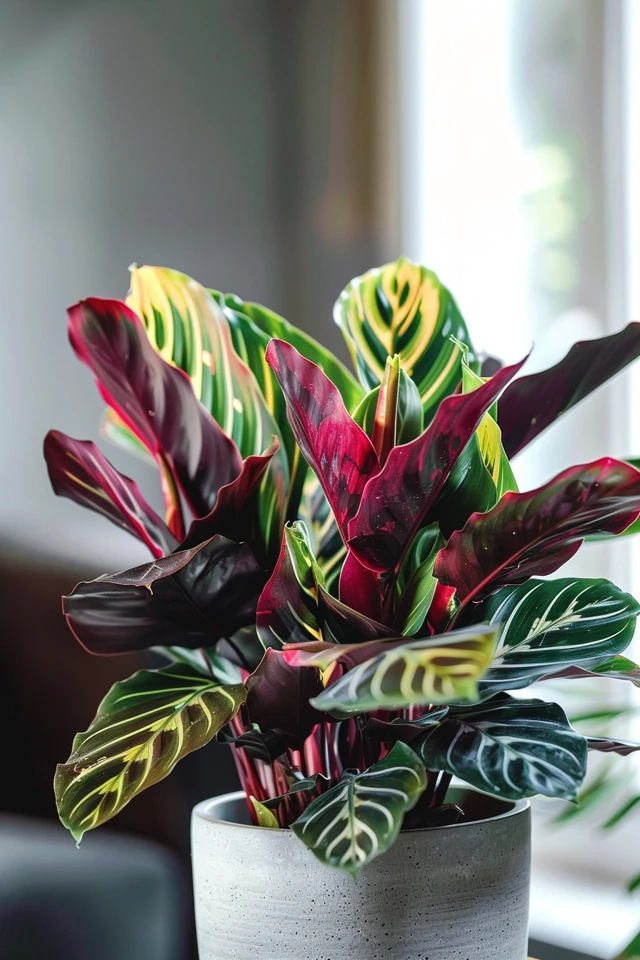The Calathea plant is a popular choice among plant enthusiasts for its stunning foliage and intricate patterns on its leaves. If you want to propagate your Calathea and expand your plant collection, plant division is an effective method to multiply your plants. In this guide, I will explain the step-by-step process of splitting a Calathea and provide you with valuable tips for successful propagation.
Propagating Calathea plants through division is best done during the spring or summer when the plant is actively growing. It allows you to create new plants with their own root system and leaves, ensuring their healthy development. By following the proper techniques and providing the right care, you can enjoy a flourishing collection of Calathea plants.

Key Takeaways:
- Calathea plants can be propagated through plant division, allowing you to create new plants with their own roots and leaves.
- Spring or summer is the ideal time to split a Calathea plant as it is actively growing.
- Before dividing, ensure the plant is well-watered and carefully remove it from its container.
- Separate the roots, making sure each clump has part of the root system and a leaf attached to a stem.
- Repot the divisions into appropriately sized containers and provide them with the same lighting conditions and temperature as before division.
Steps to Split a Calathea Plant
To propagate a Calathea plant through division, follow these simple steps:
Water the plant a few days before dividing to loosen the soil. This will make it easier to remove the plant from its pot.
Fill new pots one-third of the way with potting mix. Choose pots that are appropriate for the size of the divisions you will be planting.
Gently remove the Calathea from its pot, brushing away loose soil. Be careful not to damage the roots or the foliage during this process.
Look for natural divisions in the roots, usually where stem clusters join together. These are the points where you will divide the plant.
Using your fingers, gently separate the roots, avoiding cutting or breaking them if possible. Take your time and be patient, ensuring each division has enough roots and foliage to sustain itself.
Trim off any damaged or diseased roots using clean and sharp scissors or pruning shears. This will help promote healthy growth in the new divisions.
Place each new division into a pot, gently spreading the roots out and letting them dangle down the sides. Fill the pot with soil, making sure the division is secure.
Water the plant well until water seeps out of the drainage holes. This will help settle the soil around the roots and provide necessary hydration.
Optionally, cover the new Calathea with a plastic bag until new growth appears. This will create a mini greenhouse effect and help retain moisture.
Keep the divided plants out of direct sunlight and avoid overwatering. Calatheas prefer bright, indirect light and evenly moist soil.
Following these steps will ensure successful division and propagation of your Calathea plants, allowing you to spread their beauty throughout your home or garden.

Other Plants That Can Be Propagated Through Division
In addition to Calathea plants, there are several other houseplants that can be propagated through division. Some examples include:
- Sansevieria (snake plant): Cut the rhizome away from the mother plant, keeping some of the root system attached to the rhizome. Pot the new pup in well-draining soil and keep it out of direct light.
- Aglaonema (Chinese evergreen): Gently remove a cluster of new leaves or offsets from the mother plant, ensuring they have a good root system. Pot up the new plant in an appropriately sized pot and keep it out of direct light.
- Asparagus fern: Tease apart the root ball to separate sections of the plant from the mother plant. Pot the sections in new pots and avoid over-watering.
- Pilea peperomioides (friendship plant): Divide off the pups that grow from the fibrous root. Cut the pup with a decent amount of root and pot it in a suitable pot.
These plants can be propagated using similar techniques as Calathea plants, ensuring they have the necessary root system, stem, and leaves when divided. Experimenting with different houseplants can be a rewarding way to expand your indoor garden and share the joy of growing with others.
As with any plant propagation technique, patience and care are essential for successful results. By understanding the specific needs of each plant and providing the right conditions, you can enjoy the satisfaction of propagating your favorite houseplants and watching them thrive.


